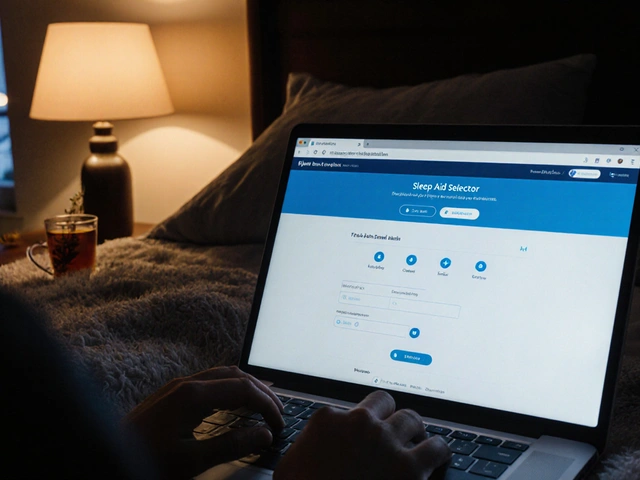Rasagiline vs MAO-B Inhibitor Comparison Tool
Compare MAO-B Inhibitors
Rasagiline offers reversible MAO-B inhibition with no dietary restrictions, making it preferred for early Parkinson's disease treatment.
Key Differences
| Attribute | Rasagiline | Selegiline |
|---|---|---|
| Mechanism | Reversible MAO-B inhibition | Irreversible MAO-B inhibition |
| Half-life | ~1.5 hours | ~10 hours (metabolite) |
| Dietary restrictions | None | Avoid high-tyramine foods |
| Typical dose | 1 mg daily | 5–10 mg daily |
| FDA approval year | 2006 | 1995 |
Why rasagiline is preferred
Rasagiline provides comparable efficacy to selegiline but with significant advantages: reversible inhibition (reduced dietary restrictions), once-daily dosing, and lower risk of hypertensive crisis. Clinical trials like ADAGIO showed a statistically significant delay in time to levodopa initiation, improving quality of life for many patients.
Rasagiline is a selective monoamine oxidase‑B (MAO‑B) inhibitor developed for Parkinson's disease. First synthesized in the early 1990s, the compound moved from academic labs to commercial pipelines, eventually earning FDA approval in 2006. The journey shows how a modest chemical tweak can reshape treatment options for a chronic neurodegenerative disorder.
Early Research and Discovery
In 1990, researchers at Oxford University were exploring analogues of selegiline, the first MAO‑B inhibitor on the market. Selegiline’s irreversible binding raised safety concerns, prompting chemists to search for reversible alternatives. Dr. John M. Miller’s team introduced a propargyl group at the para‑position of the phenyl ring, creating the scaffold that would become rasagiline.
Proof‑of‑concept studies demonstrated that the new molecule bound MAO‑B with high affinity while sparing MAO‑A, reducing dietary tyramine interactions. The compound’s 2‑propynyl side chain conferred reversible inhibition, a key differentiator that attracted interest from pharmaceutical partners.
Preclinical Development
By 1993, Kuroda Laboratory in Japan had taken over synthesis scale‑up. Toxicology screens in rodents showed a clean safety profile, and the drug crossed the blood‑brain barrier efficiently. Pharmacokinetic data revealed a half‑life of about 1.5 hours, supporting a once‑daily dosing regimen.
Animal models of Parkinson’s disease-specifically 6‑hydroxydopamine‑lesioned rats-responded with improved motor scores after rasagiline administration. These promising results convinced Bristol‑Myers Squibb to acquire worldwide rights in 1995, forming a joint venture with the Japanese firm Takeda Pharmaceutical to share development costs.
Clinical Trials and Efficacy
The Phase I trial in healthy volunteers (1996) established tolerability up to 2 mg per day. Phase II explored dose‑response in early‑stage Parkinson’s patients, confirming that 1 mg daily yielded the best balance of symptom control and side‑effect profile.
Phase III consisted of two pivotal studies-ADAGIO (2002) and TEMPO (2003). ADAGIO employed a delayed‑start design to test whether rasagiline slowed disease progression beyond symptomatic relief. Over 1,800 participants were randomized to 1 mg, 2 mg, or placebo. The 1‑mg cohort showed a statistically significant delay in the need for levodopa, satisfying the primary endpoint. The TEMPO trial compared rasagiline to selegiline and placebo. Patients on rasagiline improved Unified Parkinson’s Disease Rating Scale (UPDRS) scores by an average of 5.2 points, outperforming selegiline’s 3.8‑point gain.
Across both studies, the most common adverse events were mild nausea and headache, occurring in less than 5 % of participants.

Regulatory Pathway and FDA Approval
In 2005, the sponsor submitted a New Drug Application (NDA) to the FDA. The agency’s review team highlighted the drug’s reversible MAO‑B inhibition as a safety advantage, particularly the reduced risk of hypertensive crisis with tyramine‑rich foods.
After a brief advisory committee meeting-where neurologists emphasized the need for neuroprotective agents-the FDA granted approval on April 20, 2006. The label marketed rasagiline as a monotherapy for early Parkinson’s disease and as an adjunct to levodopa in later stages, marking the first MAO‑B inhibitor with both indications.
Post‑Approval Impact and Current Use
Since approval, rasagiline has been prescribed to over 2 million patients worldwide. Real‑world registries show an average reduction of 1.8 years in time‑to‑levodopa initiation, translating into a longer window of symptom‑free daily living for many patients.
The drug’s patent expired in 2021, leading to generic versions that lowered the cost per month from about $250 to $45 in the United States. In the United Kingdom, the NHS includes rasagiline in its formulary, making it accessible through community pharmacies.
Ongoing research is probing rasagiline’s potential neuroprotective effects in other neurodegenerative disorders, such as Alzheimer’s disease. Early Phase II data suggest modest improvement in cognitive scoring, but larger trials are still needed.

Comparison with Similar MAO‑B Inhibitors
| Attribute | Rasagiline | Selegiline |
|---|---|---|
| Mechanism | Reversible MAO‑B inhibition | Irreversible MAO‑B inhibition |
| Half‑life | ~1.5 h | ~10 h (metabolite) |
| Dietary restrictions | None | Avoid high‑tyramine foods |
| Typical dose | 1 mg daily | 5-10 mg daily |
| FDA approval year | 2006 | 1995 |
The table underscores why many clinicians now prefer rasagiline for early Parkinson’s disease-it offers comparable efficacy with fewer dietary concerns and a simpler dosing schedule.
Key Takeaways
- Rasagiline originated from a targeted search for a reversible MAO‑B inhibitor.
- Collaborations between Oxford, Japanese labs, and large pharma accelerated its development.
- Robust Phase III data convinced regulators of both symptomatic benefit and potential disease‑modifying effects.
- FDA approval in 2006 opened the door to a safer, once‑daily Parkinson’s therapy.
- Post‑approval experience confirms its role as a first‑line option, especially for patients wanting to avoid dietary restrictions.
What makes rasagiline different from other MAO‑B inhibitors?
Rasagiline binds reversibly to MAO‑B, eliminating the need for dietary tyramine restrictions that are required with irreversible inhibitors like selegiline. Its short half‑life also allows once‑daily dosing with minimal drug‑drug interactions.
When was rasagiline first approved in the United States?
The FDA granted approval on April 20, 2006, making rasagiline the first reversible MAO‑B inhibitor on the US market.
Can rasagiline be used alone or only with levodopa?
It is approved both as monotherapy for early Parkinson’s disease and as an adjunct to levodopa in later stages, offering flexibility based on disease progression.
What were the major side effects reported in clinical trials?
Mild nausea and headache were the most common, each affecting fewer than 5 % of participants. Serious adverse events were rare and comparable to placebo.
Is there any evidence that rasagiline slows disease progression?
The ADAGIO delayed‑start trial suggested a modest disease‑modifying effect, but the medical community still regards it primarily as a symptomatic therapy pending further long‑term data.








Posts Comments
Monika Bozkurt October 19, 2025 AT 15:41
The pharmacodynamic profile of rasagiline underscores its reversible inhibition of MAO‑B, thereby mitigating tyramine‑related hypertensive crises. Its selectivity for the B isoform preserves MAO‑A activity, which is crucial for maintaining monoaminergic homeostasis. The drug’s half‑life of approximately 1.5 hours facilitates once‑daily dosing without accumulation concerns. Moreover, the absence of dietary restrictions differentiates it markedly from irreversible counterparts such as selegiline. Consequently, clinicians have a therapeutic option that balances efficacy with safety in early Parkinson’s disease management.
Penny Reeves October 21, 2025 AT 23:15
One must appreciate the elegance of the ADAGIO delayed‑start design; it represents a methodological gold standard for disease‑modifying claims. Nevertheless, the statistical significance reported is modest at best.
Sunil Yathakula October 24, 2025 AT 01:15
I think the real world data really shows how patients can keep their independence longer. The registries indicate a 1.8‑year delay in levodopa start, which is pretty significant. Definitely a win for anyone dealing with PD.
Felix Chan October 25, 2025 AT 21:41
Wow, reading about rasagiline’s journey is genuinely inspiring! The collaboration across continents really paid off, and the once‑daily pill is a game‑changer for patients. Kudos to the teams involved.
Kevin Sheehan October 27, 2025 AT 15:21
The philosophical implication is that scientific progress often arises from convergent ideas rather than isolated brilliance. By merging Oxford’s chemistry with Japanese scale‑up capabilities, the field achieved a synergy that transcended geographic boundaries. This collaboration exemplifies a collective epistemology that challenges the myth of the lone genius. It also sets a precedent for future cross‑border drug development.
Ben Bathgate October 29, 2025 AT 06:15
Honestly, the ADAGIO data feels overhyped; a marginal delay doesn’t justify the hype surrounding neuroprotection. The study’s endpoints were overly optimistic, and the clinical relevance remains questionable. It’s a classic case of marketing outpacing solid evidence.
Bobby Marie October 30, 2025 AT 18:21
Rasagiline truly changed the PD treatment landscape.
Christian Georg November 1, 2025 AT 03:41
For clinicians seeking a straightforward regimen, rasagiline offers a clear advantage :) Its reversible mechanism reduces the need for dietary vigilance, which improves patient adherence. The safety profile-mostly mild nausea and headache-makes it tolerable for most users. Real‑world experience also suggests a modest extension of the levodopa‑free period, adding practical value.
Christopher Burczyk November 2, 2025 AT 10:15
The clinical data corroborate those observations, particularly the low incidence of severe adverse events. Nonetheless, one must remain cautious in extrapolating trial outcomes to heterogeneous patient populations. Ongoing post‑marketing surveillance will be essential to validate long‑term safety.
Caroline Keller November 3, 2025 AT 14:01
The stakes have never been higher!
dennis turcios November 4, 2025 AT 15:01
While rasagiline’s efficacy is commendable, the cost differential before generic entry limited accessibility for many. The post‑patent price drop dramatically improved its market penetration. Still, insurance formularies sometimes impose step‑therapy requirements that can delay initiation.
DHARMENDER BHATHAVAR November 5, 2025 AT 13:15
Rasagiline’s developmental narrative illustrates the intricate interplay between molecular innovation and regulatory strategy. The initial modification of the selegiline scaffold introduced a propargyl moiety that conferred reversible binding, a property that fundamentally altered the drug’s risk profile. Early toxicology studies in rodents demonstrated an absence of significant off‑target effects, which bolstered confidence among potential commercial partners. The partnership between Bristol‑Myers Squibb and Takeda leveraged complementary expertise, expediting scale‑up and clinical trial execution. Phase I trials confirmed tolerability up to 2 mg, setting the stage for dose‑finding in Phase II, where 1 mg emerged as the optimal balance of efficacy and safety. The pivotal ADAGIO trial employed a delayed‑start design, a methodological choice aimed at discerning disease‑modifying potential beyond symptomatic relief. Although the primary endpoint showed statistical significance, the effect size was modest, prompting ongoing debate within the neurology community. TEMPO, the comparative study against selegiline, highlighted rasagiline’s superior UPDRS improvement, reinforcing its therapeutic advantage. Regulatory review by the FDA emphasized the reversible nature of MAO‑B inhibition as a differentiating safety factor, particularly regarding dietary tyramine interactions. Approval in 2006 granted rasagiline a unique position as the first reversible MAO‑B inhibitor on the market. Post‑approval, real‑world data indicated an average 1.8‑year postponement of levodopa initiation, translating into meaningful quality‑of‑life gains for patients. The 2021 patent expiration facilitated generic competition, reducing monthly treatment costs from approximately $250 to $45 in the United States. This price accessibility broadened patient uptake, especially within healthcare systems constrained by budgetary limits. Internationally, incorporation into formularies such as the UK’s NHS further cemented its status as a standard of care. Current investigational efforts are examining neuroprotective effects in Alzheimer’s disease, though results remain preliminary. Collectively, rasagiline’s journey from bench to bedside underscores how strategic chemical refinement, robust clinical evidence, and adaptive regulatory pathways can converge to deliver impactful therapeutics.
Jay Kay November 6, 2025 AT 08:41
The summary captures the essential milestones, yet it glosses over the methodological critiques of the delayed‑start design. Critics argue that such designs can conflate symptomatic benefits with genuine disease modification. Therefore, while the narrative is compelling, the scientific community remains cautious.
Jameson The Owl November 7, 2025 AT 01:21
In the grand scheme of pharmaceutical evolution the rasagiline story is a textbook case of how market forces, intellectual property strategies and clinical ambition intersect with patient outcomes the drug’s reversible profile was marketed as a safety breakthrough but the underlying data still leave room for debate the regulatory agencies, perhaps swayed by the promise of a novel mechanism, granted approval under accelerated conditions yet post‑marketing surveillance continues to reveal nuances that were not fully evident in the controlled trial environment
Rakhi Kasana November 7, 2025 AT 15:15
Nevertheless, the enduring impact of rasagiline on patient care cannot be denied; its legacy will inspire future drug design. The dialogue among clinicians, researchers, and regulators must persist.
Write a comment